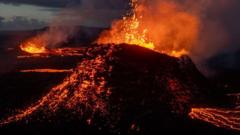In northeast Iceland, near the Krafla volcano, an ambitious scientific project is set to revolutionize our understanding of volcanic activity and geothermal energy. The Krafla Magma Testbed (KMT) plans to drill into magma, creating a unique underground observatory that could transform volcanic prediction and renewable energy.
Starting in 2027, scientists will drill two boreholes approximately 2.1 km underground. The primary goal is to instrument the magma with pressure and temperature sensors, allowing researchers to “listen to the pulse of the earth” and potentially improve eruption forecasting. This is crucial, as an estimated 800 million people worldwide live within 100 km of active volcanoes.
Iceland, with 33 active volcanic systems, has recently experienced significant volcanic activity, including eruptions in the Reykjanes peninsula that damaged infrastructure and disrupted local communities. The 2010 Eyjafjallajökull eruption, which caused over 100,000 flight cancellations and cost £3 billion, underscores the importance of better volcanic prediction.
The project has two key objectives. The first is scientific research into magma behavior, and the second is developing a new generation of geothermal power stations that tap directly into magma’s extreme heat. Currently, Iceland generates 25% of its electricity and 85% of household heating from geothermal sources.
A remarkable discovery in 2009 sparked this ambitious project. Icelandic engineers unexpectedly encountered magma at just 2.1 km depth during a drilling operation. The well produced superheated steam at 452°C, with the magma chamber estimated at 900°C. This chance encounter revealed the potential for dramatically more efficient geothermal energy production.
Researchers are developing specialized materials to withstand these extreme conditions. Traditional carbon steel loses strength above 200°C, so scientists are exploring high-grade nickel and titanium alloys that can endure intense heat, pressure, and corrosive gases.
Despite potential concerns about drilling into magma, project leader Bjorn Guðmundsson believes the process is safe. Similar interventions have occurred previously without causing explosive effects.
Internationally, over 600 geothermal power plants exist, with hundreds more planned. Researchers worldwide are exploring “super-hot rock” geothermal technologies that could access even deeper, hotter heat reserves. Each borehole in these advanced systems could potentially produce five to ten times more power than standard geothermal wells.
Rosalind Archer, dean of Griffith University, describes the KMT project as potentially “transformative” and the closest initiative to actually drilling into magma. While the work will take years, it promises advanced volcanic forecasting and a revolutionary approach to renewable energy.
The project represents a bold scientific “moonshot” that could fundamentally change our understanding of volcanic systems and unlock a powerful, sustainable energy source.




